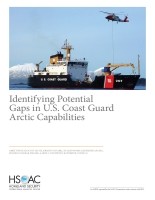| 来源类型 | Research Reports
|
| 规范类型 | 报告
|
| DOI | https://doi.org/10.7249/RR2310
|
| ISBN | 9781977400123
|
| 来源ID | RR-2310-DHS
|
| Identifying Potential Gaps in U.S. Coast Guard Arctic Capabilities |
| Abbie Tingstad; Scott Savitz; Kristin Van Abel; Dulani Woods; Katherine Anania; Michelle D. Ziegler; Aaron C. Davenport; Katherine Costello
|
| 发表日期 | 2018
|
| 出版年 | 2018
|
| 页码 | 118
|
| 语种 | 英语
|
| 结论 |
- Communications are critical to all missions, but in the Arctic, voice communications are patchy and unreliable, and transmission of data is extremely limited. Successful Department of Homeland Security (DHS) execution of a range of mission types could require the ability to communicate via voice anywhere, at any time, and with text, images, video, or other data.
- Understanding and being able to assess situations is another important aspect of conducting a successful mission. However, many threats and hazards in the Arctic are poorly understood, and there is limited capacity or capability to regularly monitor those that are identified.
- Even if a threat or hazard has been identified and communicated about in the Arctic, the potential for doing anything about it is limited by the scarcity of available assets and supporting infrastructure, combined with long distances, harsh operating conditions, and the small scale of the resources available for coordination.
- The U.S. Coast Guard (USCG) and DHS have had much difficulty in making progress toward addressing persistent Arctic challenges. Improving the USCG's capability as an institution to identify and articulate specific needs and risks could help generate momentum for closing Arctic (and other) capability gaps.
|
| 摘要 |
- DHS should spearhead more extensive planning and exercising for response in the Arctic than at present.
- The next steps for the USCG should include prioritizing Arctic CAR research to support the development of materiel and nonmateriel approaches for closing gaps. The CAR should stress the presence of capability gaps, even given the acquisition of a new heavy icebreaker, which will facilitate an important but incremental step up in capability.
- The USCG should also continue reviewing requirements for the Polar Icebreaker Recapitalization Ship to ensure this vessel is best suited to meet the demands of a multimission environment.
- A forthcoming Arctic CAR could suggest gaps that will cause the USCG to review and update its Arctic strategy, as well as develop related plans for implementation and specific concepts for different types of response.
|
| 主题 | Arctic Ocean
; Arctic Region
; Military Ships and Naval Vessels
; United States Coast Guard
|
| URL | https://www.rand.org/pubs/research_reports/RR2310.html
|
| 来源智库 | RAND Corporation (United States)
|
| 引用统计 |
|
| 资源类型 | 智库出版物
|
| 条目标识符 | http://119.78.100.153/handle/2XGU8XDN/108788
|
推荐引用方式
GB/T 7714 |
Abbie Tingstad,Scott Savitz,Kristin Van Abel,et al. Identifying Potential Gaps in U.S. Coast Guard Arctic Capabilities. 2018.
|
|
文件名:
|
x1529433758062.jpg
|
|
格式:
|
JPEG
|

|
文件名:
|
RAND_RR2310.pdf
|
|
格式:
|
Adobe PDF
|
除非特别说明,本系统中所有内容都受版权保护,并保留所有权利。